
Home page • Table of Contents • Send your writings and e-mail to: Editors@tanbou.com
- In this issue:
- Ayiti, inyon pou endepandans, ou lanmò
- Déconstruire Édouard Glissant et René Depestre
- La Nuit Miraculeuse
- The War, by Eduardo Galeano
- Utterings by G.W. Bush
- Letter to Emmuccia, born the year the war began
- A meaningful commencement address
- My Country: The World
- Liv pou li / Books to read
- Pwezi ann ayisyen
- Poésie en français
- Poetry in English
Liv ki fèk parèt • New titles • Nouvelles parutions
Liv pou li • Books to read • Livres à lire
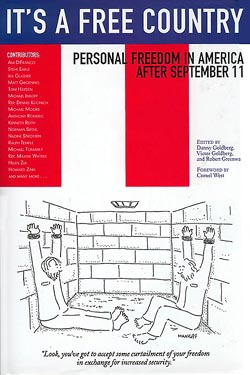
It’s a Free Country: Personal Freedom in America After September 11 edited by Danny Goldberg, Victor Goldberg and Robert Greenwald, with a foreword by Cornel West.
It’s a Free Country: Personal Freedom in America After September 11
edited by Danny Goldberg, Victor Goldberg and Robert Greenwald, with a foreword by Cornel West.
The book is a collection of work by over 50 authors, professors, artists and activists on the issue of freedom, how it is threatened in the current post-September 11 climate, and how imperative the need to defend it. In the foreword, the ever intuitive and influential professor Cornel West elucidates the mission of the book: “To bear witness to the precious truth [that] the spirit of freedom is still alive in the face of panic-driven government policies.” He ends with the warning: “The best way to pay homage to those innocent fellow human beings who were viciously killed on September 11, 2001, and those courageous fellow citizens who sacrificed their lives to rescue the innocent ones, is to ensure that their loved ones—as well as ourselves—live in an American democracy forever vigilant in its quest for freedom, and forever vigorous in its efforts to secure our precious liberties alongside our safety.”
In his introduction to the book, Danny Goldberg, one of the editors, finds encouraging that the US public at large “has internalized many civil liberties principles that only a few decades ago were considered esoteric. We want criminals arrested and punished but we believe that those accused of crimes have the right to remain silent, and have the right to an attorney.” Goldberg adds with a sense of unmystified candor: “This is cold comfort if you’re a family member of the two thousands detainees. To sit in a jail cell without knowing what you’re charged with, cut off from your family, unable to work, unsure of your future, is a Kafkaesque nightmare.”
The book comprises also a short essay by the left-wing icon Howard Zinn, historian, author of the celebrated “A People’s History of the United States”. He makes a parallel with the First World War period when the Espionage Act made it a crime “to say or write things that would ‘discourage recruitment in the armed forces of the United States’.” The suppression of free speech that this Act legalized “made all constitutional guarantee meaningless,” said Zinn, because “an atmosphere was created in which it became very difficult to speak one’s mind, either because of fear of government prosecution, or because zealous citizens, catching the war fever, harassed and persecuted fellow citizens who opposed the war.” To illustrate the tendency to authoritarianism of the US State in time of crisis, Zinn goes back as far as the Alien and Sedition Act enacted soon after the US Revolution that prohibited any dissenting discourse: “A number of who criticized the administration of John Adams were arrested and sent to prison under this Act.”
The same atmosphere of fear was in evidence after September 11, 2001, said Zinn, examples: “the intimidating proliferation of the American flags, the harassment of people from the Middle East or indeed anyone looking like a Middle-Easterner, the mass detention of non-citizens without trial or due process.” Like Cornel West and Dany Goldberg, Zinn insists on the necessity of defending civil liberties not as generous gesture but as a self-defending/preserving necessity: “The question is whether Americans will at some point begin to understand that the ‘war on terrorism’ has also become a war against the liberties of Americans, and will demand that these liberties be restored. Without the right to speak freely, to dissent, we cannot evaluate what the government is doing, and so we may be swept into foreign policy adventures with no oppositional voices, and later lament our silence.”
It’s a Free Country: Personal Freedom in America After September 11, edited by Danny Goldberg, Victor Goldberg and Robert Greenwald, with a foreword by Cornel West. Published by RDV Books /130 Fifth Avenue, 7th Floor, New York, NY 10011, and Akashic Books /PO Box 1456, New York, NY 10009. E-mail: Akashic7@aol.com; Web site: www.akashicbooks.com
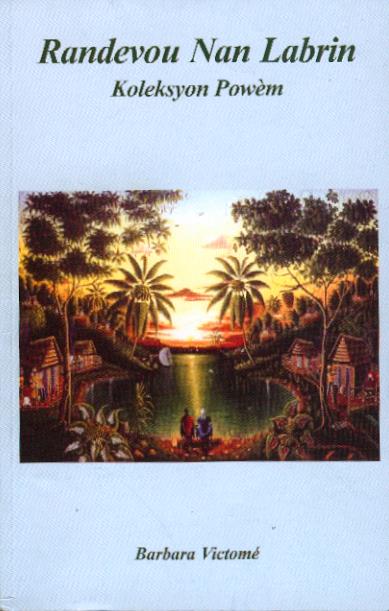
Randevou Nan Labrin koleksyon powèm pa Barbara Victomé, Edisyon Linivè Kreyòl, Brooklyn, New York, 2002
Randevou Nan Labrin
koleksyon powèm pa Barbara Victomé, Edisyon Linivè Kreyòl, Brooklyn, New York, 2002.
Koleksyon powèm sa a, premye liv Barbara Victomé, se yon travay enpòtan ki montre richès lang kreyòl la si yon powèt vle antre nan nanm li. Nan premye paj liv la, nan yon powèm ki titre «Dedikas», Victomé fè n konprann pou kiyès e pou kisa li ekri liv la:
Pou tout kokonm
Ki kontinye ap goumen
Pou yo sa gen rezon
Devan berejèn
Pou ti grenn pitimi
Ki pa ka twouve respè
Devan grenn diri
Pou tout ti wòch ki bouke tann
Diri monte chodyè
Anvan l resi goute grès (…)
Victomé fini powèm lan avèk yon vè ki sèlman endike idantite powèt la se menm idantite lektè yo, menmman-parèyman, sètfwasi gen yon konvokasyon ki fèt ki alafwa yon ekzòtasyon e yon revandikasyon pou chanje malouk e mete bèlte:
Avèk tout lapenn mwen
Tout kontantman m
E tout chimè m
Koze sa yo
Se pou nou.
Kouwè Berthony Dupont di nan yon nòt konplimantè ki pibliye sou kouvèti dèyè liv la, pwezi Barbara Victomé se «Yon pwezi natifnatal… Yon latriye imaj k ap trase dinamik lanmou nan istwa lavi kotidyen yon pèp.» Dupont konn de ki sa l’ap pale, limenm ki otè yon volim powèm rovolisyonè, Pliye Pa Kase, ki, kou Randevou Nan Labrin, ekri antyèman an kreyòl, e ki jwenn tematik chanjman e reyalite objektif sosyopolitik Ayiti yo avèk ekzotasyon kosmik pou chanje lavi. E kou tou Dupont te obsève nan yon rankont prive an ete 2002 avèk Tontongi e Victomé nan Brooklyn, sòti liv Barbara a se sèlman dezyèm fwa nan literati ayisyèn, apre sèlman Deita (Mercedès Guignard), yon ekriven fanm ayisyèn ekri yon liv antyèman an kreyòl.
Kouwè tout gran powèt, Barbara Victomé ekri nan yon fason ak istil inik, yon istil dirèk, san kache dèyè mo, yon istil preske menm defyan, ki defye espri kritik lektè a. Randevou Nan Labrin se yon liv pou tout moun dwe li; li konsakre Barbara Victomé, nan jan li jwe e rekreye lang kreyòl la, pami youn nan gran ekriven nouvèl jenerasyon an.
Randevou Nan Labrin, koleksyon powèm pa Barbara Victomé, Edisyon Linivè Kreyòl, Brooklyn, 2002. Linivè Kreyòl Publishing: 126 E 53rd Street, Suite A-5, Brooklyn, NY 11203.
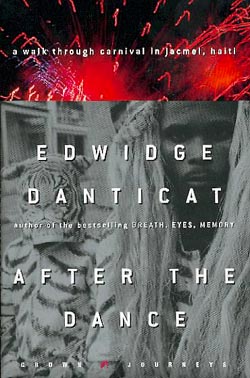
After the Dance pa Edwidge Danticat, Éditions Crown Journeys, New York, 2002.
After the Dance
pa Edwidge Danticat, Éditions Crown Journeys, New York, 2002.
Apre chelèn literè Krik! Krak e The Farming of Bones («Travay tè pou zo»), Edwidge Danticat fè sòti diran ane 2002 a de nouvo liv, Behind the Mountains, yon roman pou ti jèn fi, e After the Dance, ki se alafwa yon jounal vwayaj e memwa.
Nan After the Dance («Apre Dans»), Danticat fè etalaj yon kantite eksperyans li te pèsonèlman viv diran yon kanaval nan Jacmel, pandan menm tan l ap fè yon konik sou istwa e cham lokal vil la, san l pa manke dekri an pasan mèvèy natirèl, topografik kontre a. Li sezonnen deskripsyon l de Abitasyon Price avèk yon melanj pwezi, anpati, idantifikasyon avèk zòn lan e istwa zòn lan tankou lè l’ap pale de konvèsasyon l avèk Ovid, yon peyizan Abitasyon Price.
Si ou li angle, ou ka degiste grann kalite literati Danticat deplwaye nan liv la, tankou lè manmzèl pale de Préfète Duffaut, ann site yon pati: «Younn nan atis ki pi konni nan Jacmel, Préfète Duffaut toujou dekri Jacmel nan penti li tankou yon vil antoure ak montay k’ap fè laviwonn alantou syèl la. Nan you penti ki rele “Latè, Paradi ak Lanfè” mò yo dwe pase anba yon papòt ki gen anlè tèt li yon kwa istil Liauteaud ki vle relye syèl la ak latè. Sito yo pase anba papòp danjere sa a, yo dwe tounen swa adwat oubyen agoch; yon bò voye bay sou Lisifè e yon lanfè anflame nan nwaj, lòt bò a bay sou paradi ki gade pa zanj ki sanble zanj Endyen Arawak ki te premye abitan vil la. Paradi a, ki gen yon katedral ak ti lari k’ap desann an pant e yon simitye, gen yon pakèt resanblans ak Jacmel. Aje jodia swasant-dizuit tan, Duffaut fèk sot kreye sa anpil moun rele meyè travay li jiskisi: pwòp sèkèy pa l, dekore ak koulè briyan ki desine montay reyèl ak imajinè Jacmel yo.» [pasaj sa a tire de After the Dance, e tradui de angle pa nou, paj 31–32]
Kou ou ka wè nan tèks ki site pi wo a, ekriti Danticat anplwaye nan «Apre Dans» konstitye pwòp plezi pou li liv la; ou santi yon metriz pa yon gran ekriven de milye mwayen pou kreye nan yon lang, anmenm tan l’ap layite ba ou bèlte ak konpleksite vil Jacmel la, diferant sansiblite li ansanm avèk angwas e ideyal li. Danticat raple istwa figi madigra yo rele Chaloska a ki reprezante nan «yon pèsonaj ak inifòm militè ak bouch griyen e dan l kou grif ki baze sou yon ofisye lame reyèl, Charles Oscar Etienne, ki te konn teworize Jacmel nan debi ane 1900 yo avèk anprizonman yon mas moun, ekzekisyon somè, epitou simen dife ki detwi anpil katye. Selon [René] Depestre, pi ansyen bann Chaloska yo ki te fòme pou pase nan betiz e pwoteste anjwèt abi militè nan zòn lan, te konn montre siy sou do yo ki di “Kolonel, sa vin pi red pi devan, komandan tribilasyon nan fanmi, e jeneral kout baton dane vanjans”.» [tire de After the Dance, e tradui de angle pa nou, paj 67]
Alafen, Danticat reyalize enplikasyon kosmik ansanm ak routin òdinè eksperyans kanaval nan Jacmel lè li di: «Finalman sa te rive. Mwen te la nan kontre a. Menmlè anpil lòt moun te mete mas yo, mwenmenm mwen te pèmèt tèt mwen, sèlman pou yon apremidi, pou m te wetire mas pa m lan.» [“So it did happen after all. I had really been there. Even as others had been putting on their masks, just for one afternoon, I had allowed myself to remove my own.”]
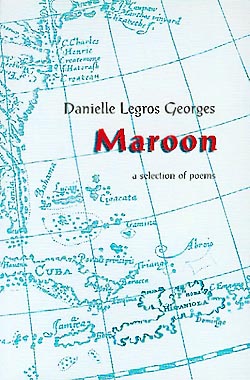
Maroon poetry by Danielle Legros Georges, Éditions Curbstone Press, Connecticut, 2001.
Maroon
poetry by Danielle Legros Georges, Éditions Curbstone Press, Connecticut, 2001.
Yon Pwofil
Danielle Legros Georges sòti an 2001 nan Edisyon Curbstone Press premye rekèy powèm li, Maroon, daprè non esklav mawon Sen-Domeng yo. Se yon liv ki byen ekri e ki pwouve metriz sofistike powèt la gen de lang angle a. Si ou wè gen pati nan liv la ki difisil pou li, se paske ekri Legros Georges gen yon kote ladann manmzèl fè eksprè pou li deroute lektè a.
Plis m’ap antre nan nanm liv Maroon lan, plis m’ap etoudi anba toubiyon mo—mo dous, mo anmè, mo flèch—liv la ap kalonnen yo, se plis m’ap reyalize liv la pa pote non li pou anyen: se ekzatteman yon mawonnaj Danielle Legros Georges ap mennen nan tout pakou liv la. Li itilize pawòl paske mo yo pou li se yon rityèl pou li devwale verite san li pa di li. Nan powèm «Anacaona» a pa ekzanp, se jiskalafen powèm lan ou vin wè—san li pa di li—ke se revanj revolisyonè powèt la mande pou redrese tò asasinasyon Anacaona pa Conquistador espayòl yo:
| «e non mwen ap vin donnen mayi
non mwen ap vin jenere vizyon jèn fi m yo ap vin nwa, bwonze, zye yo ap vin tounen loraj» |
“and my name will sow maize
my name will breed vision my girls will be black, bronzed, their eyes will be storms” (tradui de angle pa nou) |
Danielle Legros Georges itilize mo jan otrefwa sireyalis yo te itilize yo: pou pwovoke, deroute, e chanje lavi, kouwè Rimbaud te pwoklame. Li sitou itilize mo pou li jwe. Legros-Georges renmen jwe ak mo; pou li yo se kouwè klavye yon pyano w’ap tape pou ou wè jan yo sonnen oubyen yon boul ou choute pou ou wè ki kote li prale.
Powèm titre “Hen, Hen, Hen” an (ki siyifi Poul, Poul, Poul) montre tou kouman fason fantezis, «modènis»—kouwè sireyalis yo—Legros Georges pafwa aliyen mo, tankou pa ekzanp nan sitasyon pi devan yo, kote l’ap pale de yon poul:
«Yon plonje desann pye bwa
de wòch a wòch
sote tankou yon kè vyeyi
anchene nan machinri»
“A dive from tree
from rock and rock
skipping like an aged heart
chained to machinery”
oubyen:
«san repanti
Gade! Icarus k’ap leve.
Non, fanm ak zèl an metal.
Frivòl fasil petèt
men wi bat zèl li e sekwe
pye bwa poulèt sove a.»
“unrepentant.
Look! Icarus rising.
No, woman metal-winged.
Flightly hincty maybe
but flapping yes shaking
off the chick-bird tree.
Oubyen ankò:
«zèl ak travay
yon bagay
pote ak anpile
tay sere
“wing and work
a thing
bring and gather
band waists” (tradui de angle pa nou)
Sepandan, nan preske tout powèm yo toujou gen yon vè oubyen yon touni vè ki etabli pwezi klasik powèt la ka donnen tou, tankou nou wè pa ekzanp nan powèm “A Painting at the Met/Yon Tablo nan Mize Met” lan, ki osijè esklavaj:
| «Mwen wè: Koulè sann rad moun yo,
angwas ki blayi sou vizaj fi a siy detrès ki anpare pwaye sere nèg k’ap kenbe cheval la. Yo temerè, E m pat konnen si, pou yo, te gen chwa.» |
“I see: The ashen color of their clothes,
the dread that composes the woman’s face, the grip of distress in the man’s holding the horse steady. They are bold. I don’t know that, for them, there exists a choice.” (tradui de angle pa nou) |
Si ou konnen Danielle Legros Georges, w’ap rekonèt fasilman pwezi li se jan l pale, jan l keksyone sa k alantou l; tansyon nan yon mo, yon fraz, yon touni pwovokatif yon vè, se tansyon libète li revandike pou tèt li e pou tout moun. Men tou, pwezi manmzèl se kèt pou bèlte, otantisite, powetik etik e etik powetik alafwa. Powezi ki eksprime sa l ta renmen, sa li reve, kouwè sa l rejete.
Nou espere lektè yo pran plezi li de powèm Danielle Legros Georges nou tradui pi ba a. —Tontongi
Veye Lannwit
Madanm lan vire kòlè l sou mwen.
Mwen se yon senbòl pou li, yon malè,
pitit fi li pat janm genyen an
oubyen li pat janm vle
genyen an.
Si m mouri
m’ap vin
pi itil
pou li. Klou yo
ak mato li chache aswè a
ap vin konstui yon sèkèy, yon bato
ki la pou ede n flote ale.
Eske gen lontan
li te blayi yon kouvreli sou sab la,
jayisman lyè jounen k’ap chanje mond lan
an prentan, e mari li ki te la, ansanm
ak pwòp manman l, e malgre l anba zye ene yo,
dlo ak lè k’ap jwe nan limyè,
nan yon laviwonn, e nan kè l tout bagay te vivan.
Poz fim, genyen poz fim, madanm lan
di. Mwen wè vi m k’ap pase devan m
kouwè nan fim sinema.
Fim yo ap roule
rapidman
Mwen pa kwè pwòp tèt mwen
m gen laj sa a, e se vre se laj mwen.
Lannwit sa a li woze zong li vyolèt fonse
e l wetire digo plase an ti moso,
son tap, tap, tap e rès matyè gri-vyolèt
antre nan kare an bwa, tenti a antre
nan twal fabrik pare pou l pran koulè.
Yon panye depliye ak rad ble
pare pou pase, yon montay de ble
e yon men boukle alantou
fèarepase a
alantou pwa plon fèarepase a,
dwèt fi a boukle alantou yon twal
alantou manch fè a sou kote yon montay
de jip ble, abako ble, ble
yon jou ki sanble li pap janm fin pase,
ble e pa-janm-fini jou, ble
de yon preske-ble gimov, ble flè iris,
zye l koulyea ankadre ak iris, e lòt flè
plase sou kwafez fi a.
Li fè vit pou l nonmen sa k detwi l:
Lespri m klè, men kò m
ap sikonbe. Memwa m
ap sikonbe, poutan
lespri mwen
ret klè.
Mwen kapab elanse m
rapidman avèk tan.
Iris yo m te plase sou kwafez la e m te konnen
mwen pa gen anpil tan pou aprann kouman tan l te atache
kò l ak doulè, kouman li atache doulè
ak kò li, kouman l te konnen lespri l te depase
tan li e te vin tounen yon malediksyon e kouman jèn demwazèl
tounen malediksyon e kwa pou pote.
Mwen pote kwa a avè l.
Mwen konfwonte kolè l—yon fil ki mare m ak istwa l.
Papa mwen se DogonPapa mwen se Dogon.Mwen konnen sa se vre. Mwen wè li sou vizaj yon misye mwen wè k’ap mache sou Flatbush Avni. A misye m di sèlman,
Papa mwen se Dogon.
Mwen pa gen ankenn lòt prèv. |
My Father is DogonMy father is Dogon.I know this to be true. I see him in the face of a man I see walking on Flatbush Avenue. To him I say only,
My father is Dogon.
I have no other proof. |
—Danielle Legros Georges tire de Maroon, Curbstone Press, 2001 (seleksyon kòmante e tradui an kreyòl pa Tontongi)
Read more English excerpts in “Poetry in English”. (all comments and translations from English of this series are by Tontongi)
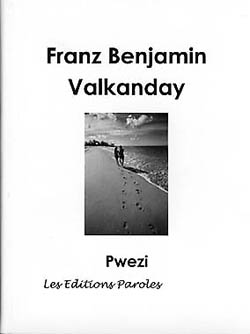
Franz Benjamin, Valkanday Les Éditions Paroles, Monreyal, Kanada, 2002
Valkanday
pa Franz Benjamin, Les Éditions Paroles, Monreyal, Kanada, 2002
«Si mwen ta kòmanse rakonte ou ribanbèl plezi ak kè kontan ki pran lespri m ak nanm mwen daso nan ekri ti liv sila a, mwen pa kwè ou t ap gen je pou fin li. Pa gen diksyonè ni silabè ki gen ase repondong pou kouve pawòl mayi mi m.
Lè yon Ayisyen ap viv sa sanba Manno Ejèn rele Ekziltik, trip ou plòtonnen ak souvnans ou nan kolepyese grenn madiòk lavi. Ekziltik blije ou marande pi fò ak lakay nan rèv ou. Rèv lavi miyò. Rèv sikdòj tablèt lakòl ak lekòl pou tout timoun ki pa gen chans reve. Mwen pa yon kreyolis ni yon kreyològ. Mwen pa menm pretann mwen se powèt kreyòl. Mwen se yon pitit lakay ki rasinen nan lang kreyòl. Se nan kreyòl mwen pran tete. Yon lang ki chèlbè ki bèl ki bòzò ki pwòp ki swa ki nèt ki drèt ki kòrèk ki legal ki ofisyèl.
Valkanday se yon moso lakay k ap fè m siyon depi lontan nan fondanman m ke m te vle pataje ak natifnatal e ak tout zanmi. Valkanday se on lòzye lanmou m pou lang manman m lan. Tankou tibebe k ap pare grangou nan tete manman yo, mwen fèmen de je m pou m tete lang lan. Anmore kase kite koupe fache pou yo ka tounen bèl driv. Lè yo tounen yo tetelang jouk solèy leve mache sou yo. Tankou tibebe ak anmore mezanmi an n kontinye tetelang lan.»
—Franz Benjamin entwodiksyon Valkanday, Les Éditions Paroles, Monreyal, 2002
Men sa Henri-Robert Durandisse di de Valkanday nan prefas li ekri pou rekèy powèm lan: «Pwezi sanba Franz la ap benyen nan yon mond de soufrans, de bonè, de lanmou. Lè yon moun kouri pou sa l santi, si m byen konprann sanba a se kouri l ap kouri pou lasoufrans men tou pou lajwisans(…)» Valkanday se yon pawòl ki plen memwa, ki chaje ak traka, ki vle di sa l santi. Lekriti sa a rakonte verite san manke yon pwèlyèm. Pou tout travay sa a, sanba Franz miyonnen pwezi jouk li derefize kite pwezi nan bwat sekrè kidonk nan yon estil pa pwoche(…)» «Pou mwen, chak paj nan Valkanday se yon jou, se yon moman. Mezanmi sanba a akòde vwal ak pa m pou swete nou bon vwayaj nan peyi Valkanday.»
Ann atandan yon pwofil pi long sou powèt Franz Benjamin, ale li kèk ekstrè de Valkanday nan Pwezi an Kreyòl. Rekèy bèl e byen ekri; li montre lanmou pou e metriz de lang kreyòl la pa otè a.

Home Page • Table of Contents • Send your writings and your letters to:Editors@tanbou.com
- In this issue:
- Ayiti, inyon pou endepandans, ou lanmò
- Déconstruire Édouard Glissant et René Depestre
- La Nuit Miraculeuse
- The War, by Eduardo Galeano
- Utterings by G.W. Bush
- Letter to Emmuccia, born the year the war began
- A meaningful commencement address
- My Country: The World
- Liv pou li / Books to read
- Pwezi ann ayisyen
- Poésie en français
- Poetry in English
- Top of this page